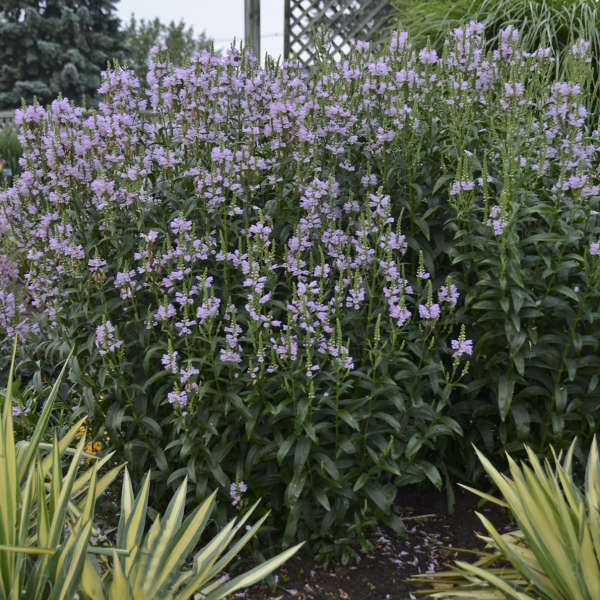Obedient Plant (Physostegia virginiana), "Rosy Spire" variety (lavender-pink flowers)
Plant Type: rhizomatous herbaceous perennial flower
Plant Family: mint (Lamiaceae)
Visual Identification: Erect tap-rooted perennial with sturdy unbranched square stems. Lance-shaped leaves are topped in late summer and early fall by spikey lavender or pink inflorescences. The individual florets are tubular and similar to snapdragon blossoms.
Native Region(s): North America, from Quebec to Manitoba south to Florida and New
Mexico
Landscape Use: Good for adding late-season flowers to a garden. Borders, cottage gardens, rain gardens, wild gardens, prairies or meadows, and the edges of ponds where the soil is moist but not water-logged. If you are concerned about its aggressive ability to spread, consider container plantings instead. Attracts hummingbirds, butterflies, and bumblebees. Deer-resistant.
Height:
3-4 feet
Spread: 2-3 feet
Spacing:
18-24 inches
Hardiness Zones: 3-9. Some sources include zones 2 and 10.
Climate Zones: prefers hot, dry regions with a temperature of 60-80°F
Light: full sun, tolerates part shade. Stalks may flop over in shadier
areas.
Water: Water once or twice a week once established. If the leaves are
drooping, the plant needs watering and may need partial shade. During
drought, the lower leaves may turn yellow and defoliate. Avoid watering
in winter.
Soil: Prefers moist, loamy, acidic (5.5 to 6.3 pH), well-draining fertile soil. Will tolerate wet or clay soils. Drought tolerant. Obedient plant will grow more aggressively in moist, rich soil.
Maintenance:
May require staking and/or pruning. Deadheading will promote further
blooming. Thin every other year: plants will thin out in the center and
can take on an open, floppy form, telling you it's time to divide them.
Wait until spring to cut back old foliage. Leave it on the plants to act
as a protective winter mulch.
Fertilize: 10-10-10 NPK fertilizer once per month in spring, summer, and fall. Don't fertilize unless the plant is showing nutrient deficiencies.
Seasons of Interest: blooms from late summer to fall, until the first frost
Floral Arrangement Uses: cut flowers
Toxicity:
non-toxic to pets and humans
Additional Resources:
-
missouribotanicalgarden.org, "Physostegia virginiana"
-
newmoonnursery.com, "Physostegia virginiana"
-
plantcaretoday.com, "Caring For Obedient Plants: Growing Physostegia
Virginiana"
-
pondinformer.com, "How to Plant & Grow Obedient Plant (Physostegia
virginiana)"
-
thespruce.com, "How to Grow Obedient Plant (False Dragonhead)"
-
wikipedia.org, "Physostegia virginiana"
|
🌱 |
𝗠𝗼𝗶𝘀𝘁, 𝗹𝗼𝗮𝗺𝘆, 𝗮𝗰𝗶𝗱𝗶𝗰, 𝘄𝗲𝗹𝗹-𝗱𝗿𝗮𝗶𝗻𝗶𝗻𝗴
𝗳𝗲𝗿𝘁𝗶𝗹𝗲
𝘀𝗼𝗶𝗹. |
|
🌤️ |
𝗙𝘂𝗹𝗹
𝘀𝘂𝗻. |
|
🌡️ |
𝗔𝗱𝗮𝗽𝘁𝗮𝗯𝗹𝗲. |
|
💧 |
𝗔𝘃𝗲𝗿𝗮𝗴𝗲 𝘄𝗮𝘁𝗲𝗿 𝗻𝗲𝗲𝗱𝘀. |
|
☠️ |
𝗡𝗼𝘁
𝘁𝗼𝘅𝗶𝗰
𝘁𝗼
𝗵𝘂𝗺𝗮𝗻𝘀
𝗼𝗿
𝗮𝗻𝗶𝗺𝗮𝗹𝘀. |





Comments
Post a Comment